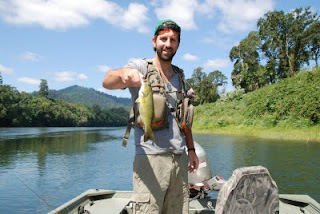So this will be my final post about smallmouth bass. At least as it relates to what I know about catching Umpqua Smallmouth Bass and the flies and techniques that work for my guests and I. I'm sure there will be future posts about the great days we'll have before the end of summer, but by the end of this post I think I will have said all there is for me to say about that, as Forest Gump would say.
By far and away, the most effective technique to get Umpqua smallies to grab your fly is the previously mentioned "on the drop" technique where we let a bead-head rubber leg nymph (i.e. girdle bug type) drop slowly through the water column until the bass swim up and eat the fly. For your part, simply let the fly fall without movement and set the hook when the bass inhales. Very simple, very effective and pretty darn fun since 95% of the hook-ups are done with you watching the whole thing unfold. Undisturbed water surface, clear flows and Polaroid glasses are all very helpful.
Everyone that fly fishes, loves to take their quarry at or near the surface whenever they can. Trout, Steelhead, Bass and a variety of salt water species are all sought while fishing on top. Its the most exciting way to get fish to grab your fly. Smallmouth on the Umpqua are no different...only they don't look up as often as I think they should. Which is to say that the number of days where we've experienced consistent surface action are fairly limited. I've not been able to really come up with an answer for this. I'm aware of other smallmouth fisheries where "top water" techniques dominate. Not so much on the Umpqua, sadly. However, when the stars align and the bass look up, the best pattern that I've found to get them to eat is a simple black and red Chernobyl ant. Red on the bottom and black on the top with long black rubber legs. That's the ticket. I've found them to me most effective when they're slapped hard on the water during the presentation. Let them sit perfectly still until all the rings disappear from the surface. Move it gently a few inches and let it set. Work the fly in this manner for a few feet or a couple of minutes per presentation. If you don't get a bass to pounce, repeat the process six to ten feet away from the last cast. Bass locate their prey in a number of ways. Sight and especially sound are the most frequently used senses. But I think sound is the most important. When you gently place the fly on the surface like you would on Silver Creek or the Metolius for trout
, you rarely get a bass to even look your way. When the fly smacks the water...HARD! bass will come from long distances (15 or even 20 feet away) to find out what that was that just crashed to the surface.
Some of my favorite smallmouth patterns. From top, clockwise; Shad fry streamer, black/red Chernobyl ant, bead head rubber-leg nymph (black) and bead-head rubber leg nymph (purple).
Every year around now (early to mid-August) the shad fry begin to school up and head down stream towards the Pacific. When that happens the bass go nuts! When this is happening we go to tiny little streamer patterns and swing them like we would for steelhead and then strip them back to the boat. The bass just smash'em! Getting a bass to grab a fly in current, that it thinks is an escaping shad fry on a tight line is a BLAST! Especially when its on EVERY CAST! After awhile it just gets kind of stupid, but that's ok...stupid suits me just fine.
Bass take a long time to grow big. A 20" fish is probably around 10 years old (maybe even older). Big bass pull hard, especially if you find them in current. Big bass are pork chop eatin' carnivors. They don't sip mayflies, they eat other bass, steelhead and salmon smolts, pike minnow, frogs, crawfish, baby ducks...you get the idea. One of the best opportunities to catch BIG smallmouth is during the spring spawn. The other thing about really large smallmouth, they almost always stay in the company of other really large smallmouth. We call them "wolf packs" because thats what they look like as they start to swarm around a small bass that you've hooked on a fly and haven't got in the boat yet. They will work together to try and get the little bass turned the right way so that they can consume the little guy. Bass have spiny rays on their back that probably makes them pretty hard to swallow tail first without causing significant damage to the larger predators digestive tract. As a result, big bass that want to eat a smaller bass always try to get the smaller fish into a position where it can be swallowed head first, never tail first.
So I guess that's it. There are other guides who have forgot more about bass than I'll probably ever know. Over the years I've had the opportunity to fish and work with the best of them. The knowledge that they've passed to me will make me forever grateful to them.
No doubt, my heart is forever with Mykiss, but when I have to fish for something other than steelhead, smallmouth are probably at the very top of my list. I hope this information will help you enjoy your days on the water chasing smallmouth too.


